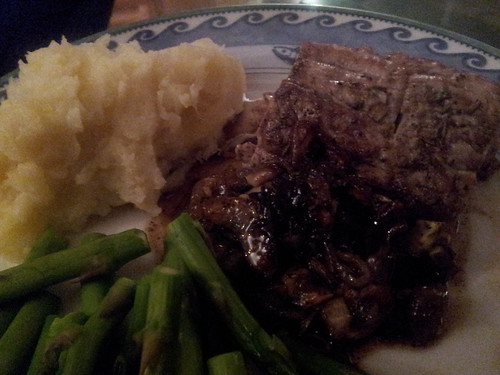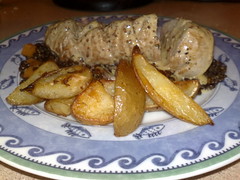The same weekend Andy announced he fancied quesadillas, he also decided he fancied some “glazed pork”. Hmmm, what cut of pork and what type of glaze?
These were questions to which he did not have answers. So I started trawling the internet for glazed pork recipes. Naturally, there are many variations on the honey and soy type glaze which I didn’t really feel like but when I came across a recipe for fillet (tenderloin for US & some UK readers) with a maple syrup and balsamic vinegar glaze I figured I’d give it a go.
I posted my recipe for baked ham on Eating Leeds (sorry, the images have all gone as I let my real hosting lapse) and this also makes use of balsamic vinegar and maple syrup so I knew this very scary sounding combination was going to work.
While I did mess around with most of the recipe (of course!) I kept the glaze as written. One big difference was that I kept my piece of pork fillet whole – I was concerned that cutting it into medallions and finishing the cooking in the oven was going to result in some seriously dry pork.
Because I like doing as much as possible ahead of time, I actually seared the seasoned pork fillet in the afternoon and set it aside.
The glaze is just 2 tbsp of olive oil, ⅓ cup of balsamic vinegar, ¼ cup of maple syrup, 2 cloves of garlic (crushed/finely chopped) and some finely chopped rosemary. You could also make this in advance and I think that would probably be preferable. I didn’t actually get time though.
When it came to cooking time, I sliced some onions and very gently fried them in the pan I’d seared the pork before adding the pork, spooning over some of the glaze and putting it into a hot (200°C) oven. While it’s cooking, pull it out every now and then, turn it over and spoon over some more glaze.
Cook until the pork is done to your liking (I think our piece took about 30 minutes to cook) – and if you’re not impatient, allowing it to rest (covered in tin foil) is always a good thing.
We served with mashed potatoes and lightly steamed asparagus. The glaze and onions from the pan makes a wonderful sauce/dressing.
This glaze would also work brilliantly with other cuts of pork – particularly pork chops.


